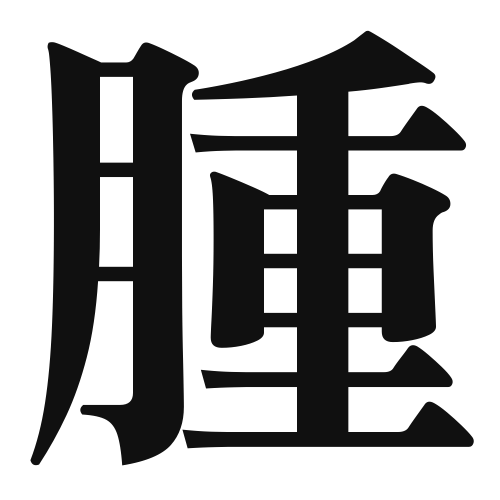1. Overview of Meaning
The kanji “腫” (shū) refers to the concept of swelling or tumor, often associated with medical conditions where tissue becomes enlarged due to various factors such as inflammation or disease.
2. Formation and Radical
Formation of the Kanji: The kanji “腫” is a phonetic compound (形声文字), which combines the radical for “flesh” (肉) on the left side, indicating its relation to the body, with the phonetic component “朱” (shū) on the right side, which provides the pronunciation.
Radical: The radical of “腫” is 肉 (niku), which relates to meat or flesh, emphasizing its connection to bodily conditions.
3. Examples of Usage
Common Words and Phrases:
- 腫瘍 (しゅよう, shuyou) – tumor
- 腫れ (はれ, hare) – swelling
Example Sentences in Daily Conversation:
- 彼は足が腫れていると言っていた。 (かれはあしがはれているといっていた。) – He said his leg is swollen.
- 医者は腫瘍の検査を勧めた。 (いしゃはしゅようのけんさをすすめた。) – The doctor recommended a test for the tumor.
4. Synonyms and Antonyms
Similar Kanji:
- 腫瘍 (しゅよう, shuyou) – tumor, which specifically refers to an abnormal growth.
- 膨らみ (ふくらみ, fukurami) – bulge, which can refer to swelling but is less specific to medical conditions.
Antonyms:
- 平 (ひら, hira) – flat, which indicates the absence of swelling or elevation.
5. Cultural and Historical Background
Relation to Japanese Culture: The concept of “腫” is significant in traditional Japanese medicine, where understanding bodily conditions and their symptoms is crucial for diagnosis and treatment.
Proverbs and Idioms: There are no widely known proverbs specifically using “腫,” but discussions about health and well-being often reference the importance of recognizing symptoms like swelling as indicators of underlying issues.
